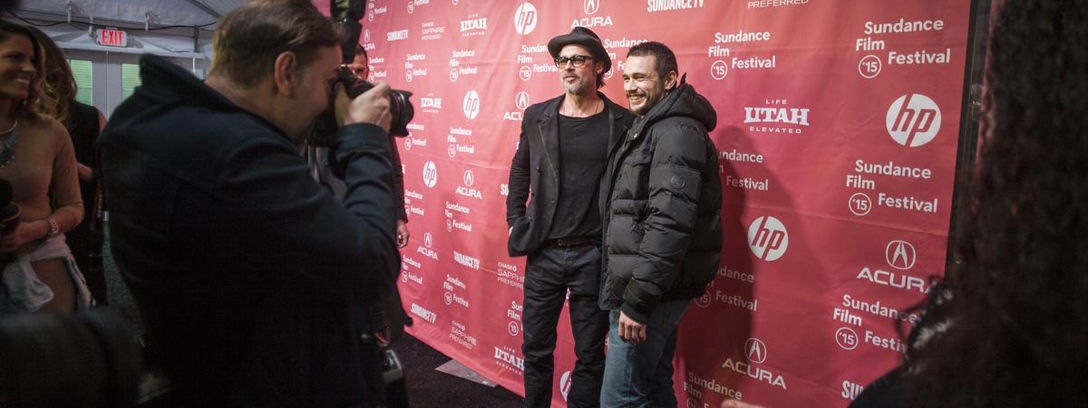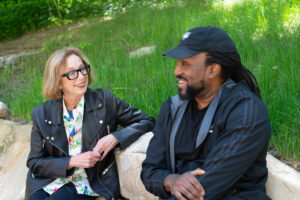Sundance Institute
Sundance.org is dispatching its writers to daily screenings and events to capture the 10 days of festivities during the Sundance Film Festival in Park City, Utah. Check back each morning for roundups from the previous day’s events.
Finders Keepers
by Eric Hynes
The story of Finders Keepers, a rollicking and sneakily emotional film that screens as part of this year’s U.S. Documentary Competition, is almost too good to be true. But as the filmmakers said after the film’s world premiere at the MARC Theater, they could never have predicted what unfolded—or that it would take six years for them to follow it.
It’s a tale you may have heard in the news, or on any number of reality TV shows. After Shannon Whisnant bought an old grill at a storage facility auction and found a human leg inside, the dismembered limb became a highly contested property issue, with Whisnant claiming purchasing rights over Wood’s…bodily rights. For Whisnant, it was a matter of principal as well as a chance to achieve fame; for Wood, it was a reminder of the plane crash that killed his father, maimed him for life, and sent him on a tailspin of addiction. While Finders Keepers is far from the first attempt to tell the story, it has depth, humanity, and a turn toward redemption that the infotainment cycle could never have captured.
“I verbally heard the story two weeks after the leg was found,” recalled producer Ed Cunningham. “So I did the research, found a great article in the Charlotte Observer, and called and asked [the reporter] what are these guys like and she said they’re amazing. Then in March of 2008 we started filming with them, and started collecting archival material at almost the same time as the story was going on.”

“Both of these families were so open and honest with us that we were really able to get into the complexity of who they are, and go through both sides even deeper than we imagined,” said co-director Bryan Carberry. But as several questions from the audience intimated—and as Wood’s body and facial language suggested whenever his adversary was mentioned—such equanimity can seem problematic once it’s clear how attention-hungry Whisnant was and remains. “If [attention] happened to be what he wanted, we gave him a platform to tell his side. Hopefully we did that truthfully,” Carberry said.
“Ed was always very honest with them. Without the other one, the story just wouldn’t be what it was. So they knew that early on,” said co-director Clay Tweel. “Just because it gives Shannon what he wants doesn’t mean he didn’t effect change for John and for himself. They’re antipodal forces that change each other’s lives.”
While Wood was on hand to receive congratulations on the sobriety that he achieves by film’s end, and to show off a fine pair of overalls, Whisnant was noticeably absent. According to Cunningham, he’s currently in jail for contempt on a weapon’s charge, and hasn’t had a chance to see the film yet.
On this point of who was getting what from whom, Cunningham was refreshingly candid and thoughtful about the unavoidable pitfalls of making a movie out of real people’s lives. “You’re exploiting people when you’re making documentary films. You have to come to grips with that,” Cunningham said. “What you have to do is hopefully rise above what other people were trying to do with this story. And try to actually let these people tell their story, instead of choosing what their story is. But there’s no doubt that there was a lot of times, because I was the lead contact with these guys, I felt conflicted about exactly what we were asking. We were doing essentially what CNN and all these other folks had done. What we tried to do was realize we were on torched land. To be respectful, and do it in a way that would represent who Shannon is a bit more deeply.”
True Story
by Jeremy Kinser
Journalistic ethics and the relationship between storytelling and the truth are at the forefront of True Story, a compelling cat-and-mouse drama that marks the debut feature from acclaimed theater director Rupert Goold. The film, which premiered out of competition at the 2015 Sundance Film Festival stars Jonah Hill as Mike Finkel, a disgraced New York Times reporter, and James Franco as Christian Longo, who’s been arrested for the murder of his wife and children. The director, who also adapted the screenplay from Finkel’s memoir, True Story: Murder, Memoir, Mea Culpa, acknowledged the importance of casting the right actors, for what is essentially a two-hander.

Although the ubiquitous Franco brings a lot of baggage to the enigmatic character, Goold shared that it was partially this reason that inspired him to cast the actor. “Because of all the things he does — his art, his novels, his experimental movies — I think there’s a sort of mystery to him, in the public consciousness anyway. You want to pursue James as a person. I think a lot of all that stuff is a construct. He’s playing with what it means to be a movie star. As a man he’s really down to earth and very normal. I find him fascinating in a way that I find Longo fascinating.”
Hill was cast as Finkel because of his “innate vulnerability,” Goold revealed. “Both of these men are in some ways unlikable narcissists. At some level I thought we had to have an actor you had sympathy for, and Jonah carries that the way most young actors don’t.” Goold decided this made the two perfect to portray the spider and the fly element of the script.
Goold sees his story’s structure as paralleling a film noir, only substituting Franco for the femme fatale. “You have a couple and the man is hypnotized away by fatal attraction or something,” he offered. “It’s as much a fascination as it is a fear.”
Larry Kramer In Love & Anger
by Jeremy Kinser
As the title Larry Kramer In Love & Anger suggests, Jean Carlomusto’s documentary isn’t a glossy valentine to the fiery AIDS activist, but an unflinching portrait of one of the most influential and divisive figures in modern American culture. The film, which will air on HBO in June to commemorate Kramer’s 80th birthday, premiered at the Sundance Film Festival in the U.S. Documentary Competition
Viewers follow Kramer through his difficult childhood, with his father berating him for being effeminate, to his success in the film industry for his acclaimed adaptation of Women in Love, his failure for the disastrous musical adaptation of Lost Horizon, which made him rich enough to later tackle activism and theatrical pursuits, culminating in his searing play The Normal Heart. Carlomusto weaves in gripping archival footage of Kramer screaming at people to fight harder to find a cure for AIDS (he calls it a “plague”) and make medicine more accessible. One interviewee compares Kramer to a prophet from the Old Testament, while another notes that “he was the pain in the ass that everyone needed him to be.”

In Love & Anger.” ©Sundance Institute | Miki Clarke
Besides his well-documented anger, Carlomusto wanted to also present Kramer’s compassionate side. “He’s honestly a deep artist, a compassionate man and a fiery activist,” she said. “I don’t consider these qualities to be at odds. People are complex.” Being a longtime friend of Kramer’s helped Carlomusto convince the author to grant her access into his life and his hospital room, where the author had begun a long, complicated recovery from surgery and where he would eventually marry his longtime partner David Webster in front of her camera. Carlomusto admitted that the ailing Kramer was initially hesitant and didn’t want the intrusion. “I did pretty much twist his arm and said I was going to do it one way or the other,” she confessed. “I go back a long way with Larry. He trained us all not to take no for an answer.”
While some of the content may be familiar to viewers who’ve seen David France’s 2012 doc How to Survive a Plague, Carlomusto insists there was no sense of competition on her part. She said both filmmakers are part of a cadre of AIDS activist videographers and that she gave footage to France for his film. “We consider our work part of a movement,” she added.
Carlomusto said due to her conscious decision to maintain an 82-minute running time, she decided to let the audience connect some of the dots. “There are certain things I didn’t want to have to state,” she mentioned. “For instance, the irony of Larry fighting back against his father for calling him a sissy and then berating us for not fighting hard enough and calling us sissies. I hope that is obvious enough that we don’t have to state the obvious. Whenever you do a documentary about a movement that’s so deep there’s always stuff that’ll get left out.”
Listen to Me Marlon and Station to Station
by Eric Hynes
As two wildly different films demonstrated on Day 7 of the Festival, cinematic innovation can come in all shapes and sizes. While Listen to Me Marlon, which screened at the Egyptian Theater as part of the World Documentary Competition, may at first seem like a standard biopic doc, recounting the life and career of film legend Marlon Brando, it does unexpected and effective things with both form and representation. Bringing together archival news footage, radio and TV interviews, movie clips, and an incredible stash of private recordings, the film is constructed so that Brando narrates his own life story. From an embattled upbringing with an abusive father and alcoholic mother, to the exultations, temptations, and ravages of fame, to triumphs, frustrations and comebacks in his career, and to the tragedies of his own children, we’re brought deep into Brando’s headspace. Yet the deeper we get into his subjective perspective, the more universal his words become. In the end he’s a man who thinks, feels and expresses intensely—the star who’s ever the conduit, even in his private musings, for our own needs and desires.

There’s also the matter of a digitally mapped animation of Brando’s head, which the actor presciently had scanned before his death in assumption that all acting in the future would be digitally derived. Director Stevan Riley, who also edited the film, said that the now outdated file had been stored on numerous hard drives that had to be run simultaneously in order to bring Brando to life, as it were. What might have been distracting, or beside point for this kind of portrait, is instead quite poignant, as the digital Brando is made to recite soliloquys from Shakespeare and narrate passages from his autobiography, altogether evoking a spirit that has passed, rather than fooling us into thinking a life has been truly recovered.
Meanwhile over at the Temple Theater, New Frontier alumnus Doug Aitken presented his singularly ambitious project, Station to Station. At once a documentary film, a digital tapestry, a series of happenings, and an elaborate, many-pronged experiment, Station to Station is 61 1-minute films, presented in succession, that were recorded over 24 days on or near a commissioned train traveling from the Atlantic to the Pacific.
The films are dominated by musical performances, as we visit stage sets by Beck, Cat Power, and Ariel Pink and witness onboard jams by Thurston Moore and others. There are also kinetic drawings dictated by train movements, digitally mapped laser art that shadows the track, photo essays, sculptures, lectures and more. The effect is unique in that it unfurls less like a feature film than as a swift deploy of ideas, images, and sounds. Instead of an attention grabbing narrative, there’s a barrage of short-attention-span information, and the effect is less about 61 indelible films than a collective, accumulative sense of creative exuberance.




